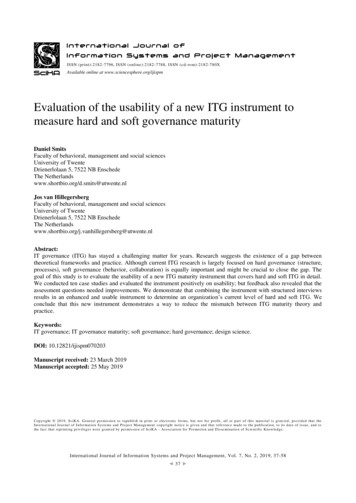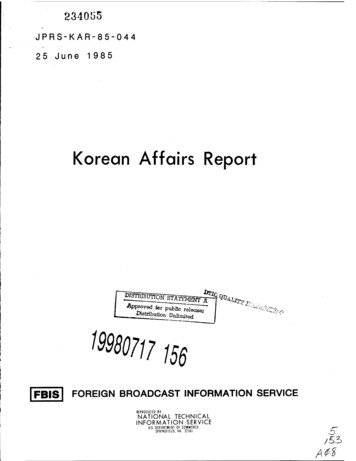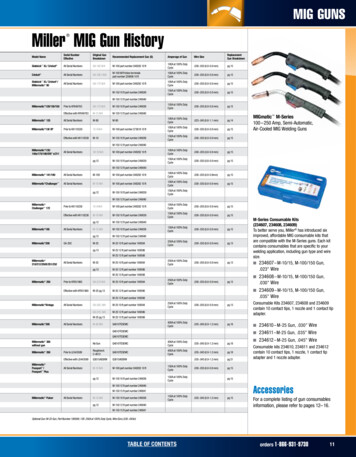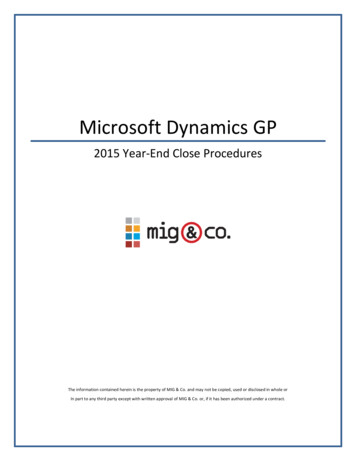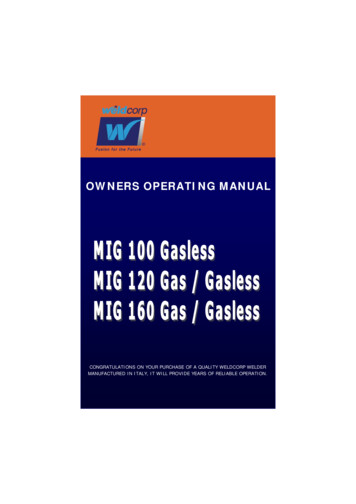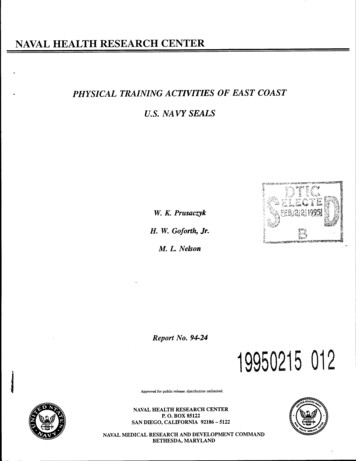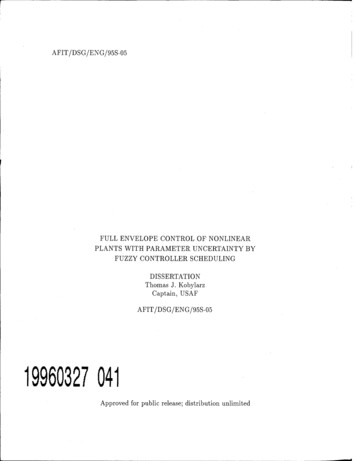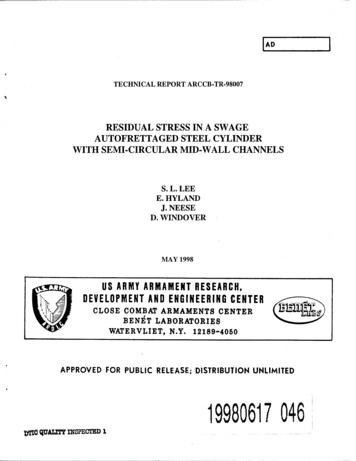
Transcription
PL-TR-95-2134Special Reports, No. 275CHRONOLOGY:From the Air Force Geophysics Laboratoryto theGeophysics Directorate, Phillips Laboratory,1985 - 1995Ruth P. LiebowitzEvelyn M. Kindler26 September 1995APPROVED FOR PUBLIC RELEASE; BISTOBOT 19951115 146PHILLIPS LABORATORYDirectorate of GeophysicsAIR FORCE MATERIEL COMMANDHANSCOM AFB, MA 01731 - 3010
"This technical report has been reviewed and is approved for publication."(Signature)RUTH P. LIEBOWITZBranch Chief(Signature)/RICHARD G. HENDLChief ScientistPhillips Laboratory, Geophysics DirectorateThis report has been reviewed by the ESC Public Affairs Office (PA) and isreleasable to the National Technical Information Service (NTIS).Qualified requestors may obtain additional copies from the Defense TechnicalCenter (DTIC). All others should apply to the National Technical InformationService (NTIS).If your address has changed, if you wish to be removed from the mailing list, or ifthe addressee is no longer employed by your organization, please notify PL/IM, 29Randolph Road, Hanscom AFB, MA 01731-3010. This will assist us in maintaininga current mailing list.Do not return copies of this report unless contractual obligations or notices on aspecific document require that it be returned.
Form ApprovedREPORT DOCUMENTATION PAGEOMB No. 0704-0188Public reporting burden for this collection of information is estimated to average 1 hour per response, including the time for reviewing instructions, searching existing data sources,gathering and maintaining the data needed, and completing and reviewing the collection of information. Send comments regarding this burden estimate or any other aspect of thiscollection of information, including suggestions for reducing this burden, to Washington Headquarters Services, Directorate for Information Operations and Reports, 1215 JeffersonDavis Highway, Suite 1204, Arlington, VA 22202-4302, and to the Office of Management and Budget, Paperwork Reduction Project (0704-0188), Washington, DC 20503.2. REPORT DATE1. AGENCY USE ONLY (Leave blank)26 September 19953. REPORT TYPE AND DATES COVEREDSpecial Report4. TITLE AND SUBTITLE1985-19955. FUNDING NUMBERSCHRONOLOGY: From the Air Force Geophysics Laboratory tothe Geophysics Directorate, Phillips Laboratory, 1985-1996. AUTHOR(S)PEPR 9993TA HOWUXXRuth P. LiebowitzEvelyn M. Kindler7. PERFORMING ORGANIZATION NAME(S) AND ADDRESS(ES)8. PERFORMING ORGANIZATIONREPORT NUMBERPhillips Laboratory/HO29 Randolph RoadHans com AFB, MA01731-3010PL-TR-95-2134SR, No. 2759. SPONSORING/MONITORING AGENCY NAME(S) AND ADDRESS(ES)10. SPONSORING /MONITORINGAGENCY REPORT NUMBER11. SUPPLEMENTARY NOTES12a. DISTRIBUTION/AVAILABILITY STATEMENT12b. DISTRIBUTION CODEApproved for public release; distribution unlimited13. ABSTRACT (Maximum 200 words)This chronology is a continuation of the 1985 report (AFGL-TR-0201, SpecialReports, No. 252) published under the title Chronology: From the CambridgeField Station to the Air Force Geophysics Laboratory, 1945-1985. Together,these two chronologies cover the fifty years of research and developmentundertaken by the Air Force's Geophysics Directorate since its foundingshortly after the end of World War II. As did the earlier chronology, thisupdate lists major organizational developments and events relating to thelaboratory's scientific programs. It also includes related illustrationsand appendices. The work is intended to provide an updated historicalreference for staff at the directorate and at related government agencies.14. SUBJECT TERMSAir Force Geophysics LaboratorySpace PhysicsGeophysics Directorate, Phillips LaboratoryAeronomyatmospheric SciencesEarth SciencesOptical/Infrared Physics ! 1;Tnnoaphpri'r Physirs" "- phtoiirsirsAarn spaca Enainaerin17. SECURITY CLASSIFICATIONW CLASSIFICATION ft SECURITYF1Ö18. SECURITYT? CLASSIFI&TIONOF REPORTUnclassifiedNSIM 7540-01-280-5500OF THIS PAGEUnclassified15. NUMBER OF PAGES5216. PRICE CODE20. LIMITATION OF ABSTRACTOF ABSTRACTUnclassifiedSARStandard Form 298 (Rev 2-89)Prescribed by AMSI Std 239-18298-102
TABLE OF CONTENTSLIST OF esion ForNTIS CRA&IDTIC TABUnannouncedJustificationDByDistribution /Availability CodesDistAvail and/orSpecial k in
LIST OF ILLUSTRATIONSFrontispiece, Overview of Phillips Laboratory, HanscomviLidar Measurements in Alaska4Balloon Launch from Antarctica9ECHO 7 Rocket Re-entering the Atmosphere11CRRES on Launch Pad at Cape Canaveral.16Photo of Aurora during STS-39 Mission19TDA High Value Targets22'.PASP Plus Instrumentation25HAARP Site in Alaska27IV
FOREWORDOn 14 September 1995 the Geophysics Directorate of Phillips Laboratory celebratedthe 50th Anniversary of its founding. This chronology reports organizational eventsand scientific programs in the directorate during the decade leading up to thisgolden anniversary year.This chronology is a continuation of the 1985 report (AFGL-TR-0201, SpecialReports, No. 252) published under the title Chronology: From the Cambridge FieldStation to the Air Force Geophysics Laboratory, 1945-1985. Together, these twochronologies cover the fifty years of research and development undertaken by theAir Force's Geophysics Directorate since its founding shortly after the end of WorldWar II.A compilation of this kind is not possible without assistance from many scientistsand staff members, both current and retired. Excellent support has been providedby the technical photo and graphics branch. The authors gratefully acknowledge allthese contributions to the report.Hanscom AFBSeptember 1995
Geophysics Directorate headquarters - 1995VJ
CHRONOLOGY1985Jan 24The Air Force Space Technology Center (AFSTC) held its firstLaboratory Program Management Review (PMR) at Kirtland AFB.AFGL "went first" and briefed both its advanced and exploratorydevelopment programs.Jan 28The Balloon Study Committee presented its findings andrecommendations to a meeting of the AFGL Corporate Body.Feb 4-25The AFGL KC-135 infrared aircraft flew eleven missions in supportof the TEAL RUBY and HI-CAMP Programs.Mar 10-15Pre-launch experiments with the Beam Emission Rocket Test(BERT-1) were carried out in the large vacuum chamber at JohnsonSpace Center, Houston, TX.Mar 14The Ionospheric Physics Division launched an instrumented rocketfrom Sondrestrom Air Base, Greenland. Supported by AFGL'sFlying Ionospheric Observatory, the rocket-borne payload measuredpolar cap arcs as part of the Polar Ionospheric IrregularitiesExperiment (PIIE) Program.Mar 15The MITRE Corporation presented a briefing on its proposedManagement Information System (MIS) to the AFGL CorporateBody.Apr 3-4AFGL participated in a joint Air Force/NASA Workshop on thePolar Orbit Environment for EVA (Extra Vehicular Activity) heldat NASA's Johnson Space Center.Apr 5The Air Force's Space Division (AFSD) announced that Col JosephR. Johnson, currently Chief, Strategic Command Control andCommunications, HQ USAF/RD, was appointed AFGL Commanderto succeed Col Joseph D. Morgan, III, who would be retiring effective31 July 1985.Apr 29The Defense Mapping Agency (DMA) announced that MSgt RogerW. Sands of the Geodesy and Gravity Branch had won DMA's 1985R&D Award for work done in the previous year.Jun 14The BERT-1 payload was launched from the White Sands MissileRange, NM, to measure electron beam propagation and vehiclecharging.Jun 17The Brazil Equatorial Astronomical Measurements (BEAM)experiment was lost as a result of a rocket mishap during launch fromNatal, Brazil.
Jun 27AFGL made recordings of seismic waves from MINOR SCALE, asimulated, surface, nuclear blast sponsored by the Defense NuclearAgency (DNA).Jun 28A competitive contract was awarded to the RCA Corporation for thedevelopment of a LIDAR (Light Detection and Ranging) system tobe included aboard the Defense Meteorological Satellite Program(DMSP) Block 5D-3 spacecraft.Jul 10AFGL's Research Library Director, Ms. Ruth K. Seidman, wasselected as the Air Force's Outstanding Technical Librarian of theyear.Jul 15It was announced that Dr. George A. Vanasse of the Infrared PhysicsBranch was the recipient of the 1985 Harold Brown Award.Jul 16Colonel Morgan, AFGL Commander, announced the restructuringof computational services at the Laboratory.Jul 18A Change of Command Ceremony was held at AFGL with Col JohnFriel, AFSTC Commander, presiding. Col Joseph R. Johnson tookup his station as AFGL Commander.Jul 29NASA launched its Spacelab II mission. AFGL participated withother agencies in making solar observations from the Shuttleplatform.Jul 31Col James K. McDonough, Director of the newly created GeophysicsPrograms Division, became AFGL's Vice Commander, succeeding theretiring Col Rodney A. Bartholomew.JulThe Air Force Systems Command (AFSC) announced ProjectForecast II.Aug 19The completed and tested Cryogenic Infrared Instrumentation forShuttle (ORRIS 1A) payload was delivered to the integrationcontractor.Sep 27The Ground-Based Remote Sensing Branch used its Doppler weatherradar to track Hurricane Gloria from south of Long Island up intonorthern New Hampshire, obtaining a major new data set forhurricane studies.Oct 5The second of two successful launches of the Balloon-Borne Ion MassSpectrometer (BIMS) took place at Holloman AFB. The instrumenttook measurements of the ion composition of the upper stratosphere(135 thousand feet).Oct 15A Cyber 860 went into operation at AFGL replacing the currentCyber 855.
Oct 25AFGL's automated digital ionosondes at Argentia NAS,Newfoundland, and at the Goose Bay Ionospheric Observatory werelinked up with the Air Force Global Weather Central's SESSComputer.Nov 17-21The Terrestrial Sciences Division shipped its Vibro-AcousticMeasurement System (VAMS) to Vandenberg AFB for installationat the V23 Shuttle launch pad.Nov 19AFGL's HARP (High-Altitude Recovery Payload) System, designedto allow retrieval of high re-entry rocket payloads from the ocean,was tested successfully on a Brazilian Sonda IV launched from Natal,Brazil.NovAFGL published its first Broad Agency Announcement (BAA) in theCommerce Daily Bulletin.Dec 5AFGL's Airborne Ionospheric Observatory provided support to theElectronic Systems Division during tests of the Over-the-HorizonBackscatter Radar in Bermuda.1986Jan 12The Space Shuttle Columbia carried the Atmospheric BackgroundsBranch's particle analysis cameras as a NASA Hitchhiker payload.Jan 28The Space Shuttle Challenger exploded shortly after take-off fromKennedy Space Center, Florida. The subsequent grounding of theShuttle fleet delayed the CRRES and CIRRIS 1A Programs andcaused the cancellation of other solar/space experiments.MarThe Ionospheric Physics Division completed a set of ultravioletmeasurements of missile plumes at Vandenberg Air Force Base, CA.Apr 8The rocket-borne SPIRIT I (Spectral Infrared InterferometricTelescope) experiment was successfully launched from Poker FlatResearch Range, AK. It obtained new high-resolution spectral dataon infrared background radiances at the earth's horizon.Apr 9-10The Critical Design Review for the prototype of the automatedCharge Control System (CCS) was completed at the contractorfacility, Hughes Research Laboratories, Malibu, CA.Apr 12After an extended "window" with no favorable launch conditions forthe payload of the rocket-borne High Resolution Infrared AuroralMeasurement (HIRAM) Program, it was shipped to Utah StateUniversity for storage until the next winter window opened.
INNMThe Geophysics Laboratory made LIDAR measurements in Alaska in 1986. Thecampaign measured atmospheric density in support of Air Force vehicles making ahigh-latitude reentry. In the background, the northern lights move across the sky.
Apr 18The Solar Research Branch at Sacramento Peak Observatory initiatedregular forecasts of the speed of solar wind, to be relayed to theAF/NOAA Space Environmental Center at Boulder, CO.Apr 20The Aerospace Engineering Division supported the Radar HomingIntercept (SR-HIT) Program at the White Sands Missile Range, NM.AprThe Blue Ribbon Commission on Defense Management (the PackardCommission) presented its report to the President.MayThe Atmospheric Sciences Division completed a three-month fieldprogram to study weather attenuation of satellite-groundcommunications.Jun 23-25A Critical Design Review for the Air Force Weapons Laboratory'sBEAR (Beam Experiments Aboard Rockets) Program was conductedat Albuquerque, NM. AFGL was responsible for payload integrationand the Aries vehicle.JunThe Earth Sciences Division conducted tests at Fort Devens, MA,which simulated the seismic effects of low-flying cruise missiles onlocal terrain.JunThe Flying Infrared Signature Test Aircraft (FISTA) completed itsspring measurements campaign, having taken data on the signaturesof cruise missiles and supersonic aircraft.Jul 11Lt Gen Forrest S. McCartney, Commander of the Air Force SpaceDivision, dedicated AFGL's newly completed Payload Verificationand Integration Facility. This building represented the first majorconstruction at the Laboratory since the completion of theComputation Center (Bldg. 1107) in 1970.Jul 19-31The Solid Earth Geophysics Branch participated in a largecooperative seismic experiment designed to image the crust ofnorthern Nevada, a region proposed for missile basing.Jul 25On behalf of AFGL, Col J. R. Johnson, AFGL Commander, acceptedthe 1986 Aerospace Unit of the Year Award from the Air ForceAssociation Greater Los Angeles Air Power Chapter 147. The awardrecognized the Laboratory's contribution to the Air Force spacemission.Jul 31The Secretary of the Air Force announced a Space Recovery Plan.One part of the plan called for the Satellite Launch Complex-6 atVandenberg AFB, CA, to go into operational caretaker status and notto be used for Shuttle launches until 1992.JulThe Optical Physics Division's SCRIBE (Strategic CryogenicInterferometer Balloon Experiment) payload made high-resolutionmeasurements of minor atmospheric constituents.
Aug25The SPIRIT II (Spatial Infrared Rocket-borne InterferometricTelescope) Request for Proposal was released to industry.Oct 14The 40th Anniversary Dinner took place at the Burlington MarriottHotel. The featured speaker of the evening was Lt Gen James A.Abrahamson, Director, Strategic Defense Initiative Organization.Oct 23With the acceptance of the cabling, the AFGL Local Area Network(LAN) became fully operational.OctThe National Aeronautics and Space Administration ended thegrounding of the Shuttle fleet after the Challenger accident andannounced a new Shuttle manifest with the first launch scheduled forFebruary 1988.Nov 13The Defense Nuclear Agency's Polar BEAR (Polar Beacon andAuroral Research) satellite was launched. It carried AFGL'sAuroral/Ionospheric Remote Sensor (AIRS) on board.Nov 18A party was held at the Officer's Club for Dr. AT. Stair, who wasretiring after a four year stint as AFGL's second Chief Scientist.DecThe Space Particle Environment Branch delivered all eighteenSPACERAD sensors for the Combined Release/Radiation EffectsSatellite (CRRES) to the integrating contractor, Ball AerospaceSystems Division. 1987Jan 9The new tri-service Military Standard 210-C, "Climatic Informationto Determine Design and Test Requirements for Military Systemsand Equipment," was published. AFGL's Atmospheric StructureBranch coordinated the technical preparation of this documentamong the three services.JanThe new VAX 8650 computer went on-line in AFGL's centralcomputer facility.Feb 26The Polar ARCS (Acceleration Region and Convection Studies)program, designed to produce improved models of polar capdynamics, concluded after a successful pair of rocket launches inGreenland.Mar 4The American Defense Preparedness Association presented theStrategic Defense Initiative Laboratory Award to AFGL for theSPIRIT I (Spectral Infrared Interferometric Telescope) Program.
AprThe testing of the CRRES (Combined Release and Radiation EffectsSatellite) spacecraft at Ball Aerospace Division was completed, andpreparations were made to store the payload until a new launchschedule was announced.AprA data link was established between AFGL and the CRAY computerat the Air Force Global Weather Central (AFGWC) to enhanceLaboratory support for the Air Weather Service.AprAFGL and ESD signed a new Memorandum of Agreement to coverLaboratory support for the Ballistic Missile Early Warning System(BMEWS) Modernization Program.MayIt was announced that AFGL's Vice Commander, Col James K.McDonough, had been reassigned to serve as Director, Space Systemsand Activities, at Air Force Space Command. Lt Col John R. Kidd,currently Director, Strategic Defense Initiative Program for the AirForce Space Technology Center, was assigned to be AFGL's newVice Commander.Jun 1-5A Critical Design Review was held for the SDI-sponsored InfraredBackground Signature Survey (IBBS) experiment, in which AFGL wasa major participant.Jun 19The Defense Meteorological Satellite Program (DMSP) launched itsF9 satellite from Vandenberg AFB, CA. The spacecraft carried twoAFGL-designed sensors for space weather forecasting (the SSJ/4particle detector and the new SSIES plasma monitor).JunScientists from the Earth Sciences Division took severalmeasurements of gravity over the entire length of the 562-meterWTVD-TV tower in Clayton, NC, in order to test Newton's Inversesquare law of gravitation.Jul 31A ribbon-cutting ceremony was held for the opening of AFGL'smodernized R&D Fabrication Center.A newly acquired,computerized milling machine was on display.Aug 7A Change of Command Ceremony was held at AFGL with Lt GenAloysius G. Casey, Commander, Air Force Space Division, presiding.Col John R. Kidd took up his station as AFGL Commander.Aug 14A rocket-borne experiment sponsored jointly by AFGL and theDefense Nuclear Agency employed a new technique for obtaining iondensities in the difficult region between 40 and 80 km.Aug 18In a ceremony at the Sacramento Peak Observatory, the facilityhousing the big dome telescope was dedicated to Dr. John W. Evans,the first director of the Observatory from 1952 to 1974.
Aug 30The Airborne LIDAR Experiment (ABLE) was launched fromRoswell, NM, to measure atmospheric backscatter from a 40 kmaltitude to simulate space-viewing geometry.Sep 1The Secretary of the Air Force announced that the Air Force SpaceTechnology Center (AFSTC) had been awarded the Air ForceOrganizational Excellence Award for exceptionally meritorious servicefrom 1 January 1985 to 31 December 1986. AFGL, as a subordinateunit of AFSTC, shared in this award.Sep 1AFGL began to receive real-time signals of lightning-strike locationsover the continental United States as part of a research program todevelop automated warning of weather events for air base operations.Sep 9-10The Space Physics Division hosted a workshop for participants in theSPEAR I (Space Power Experiments Aboard Rockets) Program, aninnovative Science and Technology program in the Strategic DefenseInitiative.Sep 9-10The Critical Design Review for the EXCEDE III InfraredInterferometer was conducted at the Center for Space Engineering,Logan, UT.Sep 16-30AFGL and NASA conducted a joint meteorological field program atOtis AFB, MA. Its purpose was to acquire truth measurements forthe Water Vapor Sounder (SSM/T-2) scheduled to fly on DMSP inthe early 1990s.Sep 17On the 200th Anniversary of the signing of the Constitution, AFGLstaff members participated in a reading of the Constitution at BostonCity Hall Plaza.SepGen Bernard Randolph announced plans to streamline Air ForceSystems Command Headquarters, including a recommendation tomerge Science and Technology with Plans and Programs to form anew Deputy Chief of Staff (DCS) for Technology and Plans.Oct 1AFGL delivered the Mark II Comprehensive update to the AirForce's micro-computer Operational Tactical Decision Aid (OTDA)to the Air Weather Service.Oct 16The Proton Prediction System (PPS), the first formally-designatedtechnology transition product completed under PE63707F,Environmental Technology Task (ETT), was accepted by Air ForceGlobal Weather Central.Oct 19Monthlong chamber experiments for the Artificial Ionospheric Mirror(AIM) Program, a FORECAST II initiative, began at the LawrenceLivermore National Laboratory.
.:%;;. -! r In January 1988 the Geophysics Laboratory successfully launched a gigantic balloonfrom Antarctica in support of the Gamma Ray Advanced Detector (GRAD)experiment, demonstrating GL's forty-year tradition of leadership in ballooning.
Oct 20-22The Ionospheric Physics Division hosted a three-day workshop onatmospheric density and aerodynamic drag models for Air Forceoperations.OctThe CIRRIS 1A payload-which had been returned from Lockheed,the shuttle integrator, following the Challenger accident-was placedin storage at AFGL's contractor, Utah State University, pending anew shuttle launch date.Nov 2The Commander announced that Mr. Brian Sandford, Chief,Airborne Measurements Branch, had been selected as the firstrecipient of the new AFGL Technology Management Award.Nov 9-13The Battan Memorial and Fortieth Anniversary Conference on RadarMeteorology was held in Boston, MA. AFGL's Weather RadarBranch was a major sponsor and participant in the event.Dec 1Dr. John F. Paulson received the Harold Brown Award for 1986 forwork on wake reduction in reentry vehicles. The ceremony at thePentagon was hosted by the Secretary of the Air Force and attendedby Dr. Brown.Dec 1-3A Sensor Integration Workshop Meeting for FORECAST IPs ProjectTechnology (PT-12) was held at AFGL.Dec 13The SPEAR I rocket-borne payload was successfully launched atNASA Wallops Island Rocket Launch Facility, VA.Dec 15AFGL published the first annual documentation of the technology ithas transferred to users during the past fiscal year, "AFGLTechnology Transition to Users, FY87."Dec 15-17A Critical Design Review (CDR) was held at Utah State Universityfor the Spatial Infrared Rocketborne Interferometric Telescope(SPIRIT II) Program.DecThe Optical Physics Division issued a new Atmospheric LineParameters Compilation (HITRAN).1988Jan 6AFGL's new toxic chemical dispersion model, AFTOX, was sent to,the Air Weather Service. It replaced the currently used OceanBreeze/Dry Gulch Model, which had been developed at AFCRL 25years earlier.Jan 8The Aerospace Instrumentation Division launched the first large,helium-filled, free balloon ever to be flown in Antarctica in supportof the Gamma Ray Advanced Detector (GRAD) experiment.10
A TV camera on a free-flying, diagnostic payload caught this picture of the ECHO 7rocket reentering the atmosphere over Alaska on 8 February 1988. This is the firstimage of a man-made electron beam being emitted in space.11
JanMr. Joseph Hess, AFGL's longtime representative on the West Coast,retired.Feb8The AFGL/NASA/University of Minnesota ECHO-7 rocketexperiment was launched from the Poker Flat Research Range, AK,to investigate the propagation of electron beams in space.Feb 18The Gravity Gradiometer Survey System (GGSS) hardware,developed by AFGL, was officially delivered by the contractor, BellAerospace Textron, to the Defense Mapping Agency.FebThe Air Force Space Test Program announced that the ORRIS 1Aexperiment was rescheduled for a Shuttle launch on STS-39 inJanuary 1990.May 14The Laboratory celebrated the inauguration of its newly completedScience Conference Center with an Open House.May 17Dr. Allen G. Rubin, Dr. David L. Cooke, and Mr. Charles P. Pikewere presented with a special Award for Technology Transfer fromthe Federal Laboratory Consortium for transferring their satellitedesign technology to industry.MayThe Air Force announced that it planned to mothball the ShuttleLaunch Complex (SLC) at Vandenberg AFB, CA, and to conduct itsShuttle missions from Cape Canaveral, FL.Jul 11-15A Delta Critical Review was held for the reconfigured CRRESsatellite, now scheduled to be launched in June 1990 on anAtlas-Centaur rocket.Aug 17The Threshold Test Ban Treaty (TTBT) Joint VerificationExperiment between the US and the Soviet Union was initiated.Aug 24-26Shuttle astronauts visited AFGL to train for flight operations withAFGL's Cryogenic Infrared Radiance Instrumentation for Shuttle(CIRRIS 1A) experiment.AugRepresentatives from Brazil's Centro Tecnico Aeroespacial (CTA)visited AFGL to discuss rocket-borne experiments.Sep 1AFGL's Cooperative R&D Agreement with the ONTAR Corp. todevelop and market a PC-version of AFGL's atmospherictransmission code, LOWTRAN-7 (the first CRDA signed by the AirForce) was approved.Sep 15The Atmospheric Balloon-borne LIDAR Experiment (ABLE) had asecond successful flight over the White Sands Missile Range, NM.Sep 29After a 33-month hiatus following the Challenger accident, the SpaceShuttle resumed operations with the launch of the Shuttle Discovery.12
SepThe 56 kilobit satellite link from AFGL to the CRAY II at the AirForce Weapons Laboratory, Kirtland AFB, NM, became operational.Oct 8Dr. Richard G. Hendl, Director of Technical Plans and Operations,was appointed to be the Laboratory's third Chief Scientist, replacingDr. A.T. Stair, who had retired in 1986.DecThe Space Shuttle STS-27 carried the Air Force GeophysicsLaboratory's (AFGL's) hand-held camera for cloud photography.Additional cloud data were obtained on the Shuttle Columbia(STS-28) in August 1989.1989JanDuring its second expedition to Antarctica, AFGL tested Pathfinderballoons to gain further knowledge about the Antarctic stratosphereand balloon behavior in that environment.JanSimultaneous satellite and aircraft measurements verified that theSpecial Sensor for Ions, Electrons, and Scintillation (SSIES) on theDefense Meteorological Satellite Program (DMSP) can identifyhigh-latitude scintillations.Mar 13-14As Solar Cycle 22 approached its maximum, solar activity gave riseto a major geomagnetic storm producing radio propagationanomalies, enhancement of the neutral atmospheric density atsatellite altitudes, and a major blackout of an electrical power system.Mar 9Maj Gen Thomas Brandt, AFSC Chief of Staff, announced someorganizational redesignations. The Air Force Geophysics Laboratorywas redesignated the Geophysics Laboratory (GL) with AFSC addedfor identification.MarA GL scientist, Ms. Janet C. Johnston, descended 13,000 feet into aSouth African gold mine to conduct seismological studies, setting therecord for descent into the earth by a woman.AprAt the end of a five-year contract, Hughes Research Laboratoriesdelivered a prototype Charge Control System (CCS) to GL.AprGL installed an all-sky imaging photometer at Station Nord,Greenland, to improve coverage of ionospheric disturbances over thepolar cap.Jun20The Geophysics Laboratory, together with the Royal Signals andRadar Establishment, began a four-week South Atlantic BackscatterLidar Experiment (SABLE 89) from Ascension Island. It evaluatedaerosols and cirrus clouds as tracers for winds to be measured bysatellite-borne lidar.13
Jul 13The Beam Experiment Aboard Rocket (BEAR) was successfullylaunched on an Aries rocket from the White Sands Missile Range,NM. GL was the system integrator for this neutral particle beamexperiment, sponsored by the Strategic Defense InitiativeOrganization (SDIO), as well as providing the booster and all supportsystems.Aug 24There was a Change of Command Ceremony at the Laboratory. ColRobert J. Hovde assumed command of GL at a ceremony presidedover by Col J. R. Johnson, AFSTC Commander.Aug-SepThe United States and the USSR conducted a Joint VerificationExperiment (JVE) to test verification measures for the ThresholdTest Ban Treaty. The first round was held at the Nevada Test Site,17 August; the second at the Shagan River Test Site, 14 September.Sep 16The Flying Infrared Signatures Technology Aircraft (FISTA) obtainedhigh-quality data on an SDIO-sponsored chemical release in the highatmosphere.SepThe Airborne Ionospheric Observatory (AIO) flew runs in supportof the development, test, and evaluation (DTE) process for theContinental United States (CONUS) over-the-Horizon Backscatter(OTH-B) Radar.SepThe Earth Sciences Division signed a Memorandum of Agreementwith the Air Force Technical Applications Center (AFTAC) forseismic research in support of nuclear test ban treaties.SepThe Laboratory began distribution of the third edition of itsAerospace Environment wall chart.Oct 3The USAF/NASA Combined Release/Radiation Effects Satellite(CRRES) underwent thermal vacuum testing at Ball AerospaceSystems Division in Colorado.OctGL delivered the Space Plasma Monitor for the DefenseMeteorological Satellite Program (DMSP) S14 spacecraft.OctThe EXCEDE III rocket-borne experiment completed sensorintegration tests.Nov 15The Cryogenic Infrared Radiance Instrumentation for Shuttle(CIRRIS 1A) payload passed its Phase 3 Safety Review.NovThe Air Force Systems Command announced that its field unitswould be taking a 10% cut in personnel over the next three years.DecThe Air Force announced a series of actions regarding militarypersonnel which were designed to increase early separations andretirements from the service.14
DecThe T-1 link between the GL Cyber and the CRAY 1 super computerat Air Force Space Technology Center went into operation.1990Jan 11The Secretary of Defense released the Defense Management Report(DMR) spelling out how the Pentagon would fully implement therecommendations of the 1986 Packard Commission. It also instituteda total in-position freeze on civilian hiring.Jan 12The Long Duration Experiment Facility (LDEF) was retrieved by theSpace Shuttle after five years (instead of the originally planned oneyear) in orbit. GL had both material and cosmic ray experiments onthe LDEF.JanManagement and staff members at GL started to attend sessions ofTotal Quality Management (TQM) Awareness Training.JanAs part of the DMR process, the Department of Defense initiateda study on consolidating DoD Laboratories, and the Air Force begana separate set of studies on consolidating AFSC product divisions andlaboratories.Jan-FebGL scientists and staff at
HAARP Site in Alaska 27 IV . . Apr The Blue Ribbon Commission on Defense Management (the Packard Commission) presented its report to the President. . Jun 23-25 A Critical Design Review for the Air Force Weapons Laboratory's BEAR (Beam Experiments Aboard Rockets) Program was conducted at Albuquerque, NM. AFGL was responsible for payload .



